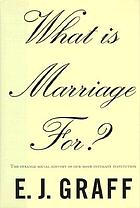While Cott is an academic historian, Graff is a journalist -- and the differences in these two books reflects that to a great extent. This is not to say one is better than the other: Nancy Cott's work is a carefully-delineated study of American marriage from the Revolution to the late twentieth century while Graff's is a more wide-ranging exploration of what marriage has been and meant in the West over the past two millennia. Both work in their own ways to point out that the present-day arguments about the demise of "marriage culture" and/or the end of civilization as we know it because of [insert marriage change of your choice] is actually nothing new. Reactionaries have been raising a hue and cry in every era about the passing of one concept of marriage in favor of another, and our current notion of what "traditional" marriage looks like (what Cott referred to as Christian monogamy grounded in affection and entered by mutual consent) is actually a fairly new -- Graff would even say radical -- departure from the marriage norms of our forebears.
While for Cott the question of same-sex marriage is almost a coda to the main body of her argument -- which centers around non-white peoples' and women's citizenship rights and how they interact with marriage law -- same-sex relationships are the raison d'etre of Graff's work. After marrying her partner, Madeline, in 1992, Graff began to explore the slippery history of "marriage" and its meaning, with the goal of answering the question of whether same-sex couples can or do reasonably occupy the same space as other-sex couples in the present-day landscape of marriage beliefs, law, and practice. It will perhaps come as no surprise that Graff's answer is, again and again, that yes same-sex couples fit quite abley into our current notion of what a marriage is and does:
There remains an uneasy tension between, on the one hand, marriage as a way to resist consumer capitalism's pressure on the individual soul -- and, on the other, to fulfill consumer capitalism's ideology of individual love and commitment. But [today's reactionaries] wrongly choose those who love among the same sex as their scapegoats. The move toward same-sex marriage is the consequence, not the cause, of many other changes in Western life -- changes like legalized contraception, already inscribed in Western laws. A pluralistic democracy cannot fairly bar as pariahs people who fully fit its ideology of the meaning of sex within marriage (87).There were a few details in analysis upon which Graff and I disagree, such as her argument that the logic that allows for same-sex relationships (modern notions of love and personal choice) does not allow for polygyny, since the reasons for polygyny have traditionally been about political alliances and patriarchal kinship consolidation. While true insofar as it goes, her conclusion that therefore same-sex relationship recognition is in NO WAY related to recognition of more-than-two marriage models seems to ignore the way in which modern polyamory also draws on notions of love and personal choice. But that's overall a small quibble with what is an entertaining and well-researched exploration into the slippery meaning of something we think we all "know" when we see (or enter into) it.

No comments:
Post a Comment